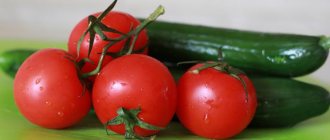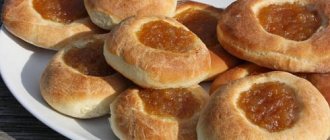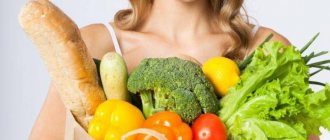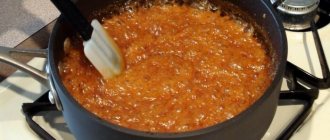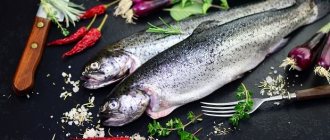Foods containing complex carbohydrates
It is known that carbohydrate compounds help provide the human body with the necessary amount of energy. Calculation of carbohydrate norms should be made depending on physical activity. The more calories a person spends while playing sports or leading an active lifestyle, the more carbohydrates he needs to consume. To restore strength, not to gain excess weight, or vice versa - to promote weight loss, you need to carefully plan your diet. Particular attention should be paid to counting carbohydrates for diabetics, as well as people prone to obesity.
When consuming large amounts of carbohydrates, it is necessary to process them, otherwise the compounds will contribute to the appearance of fat deposits. In addition, there are two types of carbohydrates that have characteristics of interaction with the body - simple and complex. Complex carbohydrates, also called slow carbohydrates, have a low glycemic index (they do not contribute to a strong increase in blood sugar). They can be eaten regularly and do not cause increased weight gain. In what products can you find their high content:
- Many vegetables - potatoes, tomatoes, spinach, cucumbers.
- A variety of cereals, for example, buckwheat.
- Legumes.
- Nuts.
- Durum wheat varieties.
Slow carbohydrates
Many foods containing slow carbohydrates have high nutritional value and help the body function normally. They are the basis of proper nutrition and must be consumed. The daily intake of foods containing carbohydrate compounds ranges from 250 to 580 grams, depending on a person’s physical activity. What are the benefits of slow carbohydrate compounds:
- These are high molecular weight substances - polysaccharides. Unlike simple, easily digestible (fast) carbohydrates with one or two molecules, they are absorbed into the blood much more slowly, which ensures a feeling of fullness. And this is especially necessary when using an easy method of losing weight (diet) and proper separate nutrition.
- When consumed wisely, polysaccharides do not contribute to weight gain. In addition, many products containing them are rich in other vitamins and microelements that inhibit the absorption of carbohydrate substances into the blood. Fast carbohydrates are almost immediately converted into fat.
- Polysaccharides do not cause sudden spikes in blood sugar. Due to the complexity of their molecular structure, they are absorbed by the walls of the stomach for a long time, which ensures a gradual saturation of the body with energy. Another difference from simple carbohydrates is that when they enter the bloodstream, they cause a sharp, but not too long-lasting jump in sugar. Energy appears, but the feeling of fullness quickly passes. Products containing fast mono- or disaccharides are said to have a high glycemic index.
People suffering from diabetes need to consume even polysaccharides with caution. For them, doctors have developed a special “bread unit”. One XE is equal to 10 grams of carbohydrates. During one meal, a man with diabetes can eat 4-5 such units, a woman - 3-4, during snacks - 1-2.
Boiled vegetables diet
The products are included in dietary salads and soups. Boiled vegetables for weight loss are very important because they have become the main components of several types of diets. The principles and rules of the most effective of them are presented in the table:
| Diet name | Duration, expected effect | Authorized Products | Prohibited Products | Rules for losing weight |
| Protein-vegetable | 4 or 7 days, from 2 to 5 kg |
|
|
|
| Fruit and vegetable | 5-7 days, from 5 to 10 kg | Any boiled vegetables, fruits (except prohibited ones) |
|
|
| On vegetable soups | No more than 7 days, about 5 kg | Any fruits and boiled vegetables, excluding starchy ones. Between servings of soup, it is permissible to add raw vegetables or fruits to the menu. | Starchy foods (potatoes, corn) | Only one main dish is consumed - vegetable soup, prepared according to certain rules. |
| Curd and vegetable | 14 days, up to 7 kg |
| Starchy foods |
|
| Kefir-vegetable | 7 days, from 3 to 5 kg |
|
|
|
List of foods rich in carbohydrates
A list of foods containing the maximum amount of carbohydrates will help you create the right diet to replenish your energy reserves. The most carbohydrate compounds are found in cereals, legumes, some types of vegetables, and nuts. In which foods should you look for the largest amount of mono-, di- and polysaccharides?
- Split pea grain.
- Beans.
- Lentils.
- Boiled corn.
- Bananas.
- Dried rose hips.
- Cashew nuts.
- Pine nut.
- Corn, pearl barley, rice, semolina, buckwheat, barley porridge, rolled oats.
- Rice, rye, wheat flour.
- Wheat, creamy crackers.
What foods do not contain carbohydrates?
There are food products that contain almost no carbohydrate compounds - neither fast nor slow. They are often included in carbohydrate-free diets, the adherents of which recommend almost completely abstaining from carbohydrates: an example is the well-known Kremlin diet. Nutritionists do not recommend sticking to such a diet. For those who want to lose weight, it is advisable to reduce the consumption of carbohydrate compounds, however, by giving them up completely, a person risks suffering greatly by disrupting the metabolism.
An unhealthy diet without carbohydrates will cause weakness, fatigue and other side effects. To lose weight, healthy nutrition experts recommend not exceeding the daily intake of foods with carbohydrate compounds. In addition, it is necessary to give up polysaccharides and disaccharides - white sugar, sweet fruits and baked goods, which only bring harm to the body. Non-carbohydrate foods should be consumed in the evening with your last meal. These include:
- Veal, chicken, rabbit meat.
- Quail, duck, chicken eggs.
- Liver, heart.
- Shrimp, crabs.
- Grain curd.
- Yogurts.
- Vegetables: cabbage, bell peppers, artichokes, zucchini.
- Oranges, grapefruits.
The consumption of carbohydrate foods should be in the first half of the day - this is necessary, firstly, to fill the body with energy, and secondly, so that the substances are not converted into fats at night. In the evening, you should give preference to healthy, light, low-calorie, non-carbohydrate foods described above. According to statistics, proper nutrition with a normal protein-fat-carbohydrate ratio is much more effective than carbohydrate-free diets.
The best foods for weight loss
The main goal when losing weight is to saturate the body with nutrients without adding unnecessary calories.
Pay attention to products with low fat content; the method of preparing the dish also matters. It is preferable to steam, boil or bake food in the oven.
The best foods for weight loss in the table:
| Product category | Recommendations |
| Meat products | Choose boiled chicken breasts or cook lean beef or lean pork in the oven. The egg white should be separated from the yolk to reduce the calorie content of the product. Avoid all processed meats. |
| Dairy | Opt for low-fat milk, cottage cheese, yogurt and kefir to fill your body with protein without extra calories. |
| Fish and seafood | Steamed or grilled fish and seafood can be added to the diet without restrictions. |
| Vegetables | Reduce your consumption of potatoes and corn. Prefer using fresh vegetables for salads or steaming them. |
| Fruits | Eat fruits only fresh. Fresh fruits are low in calories, with the exception of avocado and banana, but contain a lot of fructose, which is a fast carbohydrate. If you want to lose weight, consider this fact. |
| Beverages | Water, coffee and tea without milk and without sugar in unlimited quantities. Other drinks should be avoided during weight loss. |
| Nuts and seeds | No more than 10 nuts per day, taking into account their calorie content in the daily diet. |
| Cereals and legumes | Cook porridge in water. You should not avoid complex carbohydrates when losing weight - without them, you will quickly break down and break your diet. |
| Pastries and sweets | Avoid while losing weight and limit after this period. |
| Sauces | To dress the salad, just sprinkle it with vegetable oil, vinegar or lemon juice. |
Table of carbohydrate content and calorie content in foods
When preparing meals, it is important for a person watching their diet to know about foods containing large amounts of carbohydrates in order to replenish the body’s energy reserves. Vegetables, fruits, cereals, mushrooms, flour to varying degrees help saturate the body with essential substances. It is worth remembering that the calorie content of ready-made dishes may differ, and some slow carbohydrate compounds after heat treatment become “bad” fast carbohydrates. Table of carbohydrates in different foods:
| The product's name | Amount of protein per 100 grams | Kilocalories per 100 grams |
| Vegetables, melons | ||
| Boiled corn | ||
| Potato | ||
| Green pea | ||
| Green olives | ||
| Parsley root | ||
| Onion | ||
| Pea grain | ||
| Lentils | ||
| Whole pea pods | ||
| Green peas | ||
| Apricots | ||
| garden plum | ||
| Plum sloe | ||
| Mandarin | ||
| Dried rose hips | ||
| Fresh rosehip | ||
| Grape | ||
| Garden rowan | ||
| Mulberry | ||
| Chokeberry | ||
| Gooseberry | ||
| Dried boletus | ||
| Dried boletus | ||
| Dried whites | ||
| Fresh boletus | ||
| Fresh boletus | ||
| Fresh boletus | ||
| Fresh russula | ||
| Fresh milk mushrooms | ||
| Fresh whites | ||
| Seeds and nuts | ||
| Pine nut | ||
There is probably no person now who has not heard the word “calorie”. But not everyone understands what exactly it means. The term was first introduced by Swedish physicists back in the 18th century and was used to determine the heat of combustion of fuel. Now the concept of “calorie” is used in utilities and energy, as well as to indicate the value of products. The word gained the greatest popularity in the latter meaning. Calories in foods are the amount of energy entering the body during their digestion and complete absorption. A person spends it on maintaining the functioning of his body, on daily activities, and spends it constantly, even in his sleep. This energy is usually defined in kilocalories (abbreviated as kcal). It is also possible to calculate in kilojoules (kJ), which are similar units of measurement.
Vegetable calorie table
Use only fresh ingredients for cooking. Place some of the fruits in a special container on the table - they will always be in sight, prompting you to experiment unusually, awakening your imagination and forcing you to create culinary masterpieces. Put the other half in the refrigerator - at low temperatures they last longer, remaining beautiful on the outside and juicy on the inside.
Calorie table for vegetables per 100 grams
| Product | Kcal | Proteins (g) | Fat (g) | Carbohydrates (g) |
| Potato | 75,7 | 1,8 | 0,6 | 14,9 |
| Jerusalem artichoke | 61,03 | 2,34 | 0,1 | 13,1 |
| Sweet potato | 60,22 | 2,1 | 0,24 | 14,3 |
| Kohlrabi | 44,13 | 2,72 | 0,1 | 8,17 |
| Beet | 42,1 | 1,6 | 0,15 | 8,69 |
| Hot pepper | 40,7 | 2,1 | 0,5 | 7,5 |
| Swede | 37 | 1,1 | 0,12 | 7,5 |
| 35,9 | 2,47 | 0,29 | 6,51 | |
| Carrot | 35 | 1,43 | 0,17 | 7,28 |
| Brussels sprouts | 35 | 5,14 | 0,2 | 3,2 |
| Broccoli | 34,12 | 2,6 | 0,63 | 7,1 |
| Turnip | 32 | 1,49 | 0,17 | 6,36 |
| Cauliflower | 30 | 2,62 | 0,38 | 4,4 |
| Artichoke | 28,2 | 1,24 | 0,19 | 5,35 |
| Tops | 28,2 | 1,12 | 0,18 | 6,17 |
| Gherkin | 28,2 | 1,2 | 0,1 | 4,9 |
| White cabbage | 28 | 1,53 | 0,11 | 5,3 |
| Red cabbage | 26,2 | 1 | 0,2 | 4,8 |
| Bell pepper | 26 | 1,5 | 0,1 | 5 |
| Ground tomato | 24,12 | 1 | 0,2 | 4,1 |
| Zucchini | 24 | 0,63 | 0,32 | 4,6 |
| Eggplant | 23,9 | 1,11 | 0,19 | 4,83 |
| Pumpkin | 22,5 | 1,42 | 0,15 | 4,61 |
| Radish | 20 | 1,45 | 0,17 | 3,47 |
| Pattison | 19,3 | 0,54 | 0,1 | 4,33 |
| Chinese cabbage | 16 | 1,24 | 0,2 | 2 |
| Ground cucumber | 14 | 0,83 | 0,15 | 2,61 |
Remember that zucchini takes the longest to digest in the intestines and tomatoes and, oddly enough, potatoes are the fastest to digest.
Calories in foods
The energy contained in food products is of greatest interest. In production, their exact value is measured in a special device, a calorimeter, by burning it in a sealed chamber. The amount of heat released during this process is the energy value. This is how the manufacturer determines how many calories are in the food. To inform buyers, this value is applied to the packaging in which the product will be sold. The number of calories in foods is usually indicated per 100 grams of weight.
Calorie content of dishes
Vegetables are the basis of human summer nutrition. In winter, the choice of products is narrowed by the peculiarities of their storage, but some vegetables are prepared all year round.
The table includes the calorie content of popular vegetable-based dishes.
When following a diet, a calorie table is not always necessary. In most cases, limiting the amount of carbohydrates in the diet is required. The high energy value of some products is ensured by the content of fats and proteins rather than carbohydrates.
Popular protein-rich plant foods include:
- beans;
- soybean asparagus (Chinese fuzhu);
- nuts (walnuts, brazil nuts, almonds, hazelnuts);
- whole grain;
- brown rice;
- bananas;
- spinach;
- sunflower seeds;
- soya beans;
- avocado.
All nuts and vegetable oils are rich in fats.
Carbohydrates can be obtained from foods such as:
- pumpkin;
- dried beans, peas;
- corn;
- White rice;
- buckwheat;
- potatoes, Jerusalem artichoke and sweet potato;
- rye, oats.
Food and weight
Having found out that calories in foods are energy entering the body, it is not so difficult to understand that its excess can lead to excess body weight gain. But nutritional value is also important, that is, the amount of carbohydrates, fats and proteins. These concepts are interconnected. It is not without reason that it is believed that excessive consumption of fatty and sweet (high-carbohydrate) foods leads to excess weight gain. Just look at the calories in foods. The 100 gram chart for carbohydrates, fats and proteins is given below.
That is why the labels indicate not only the energy value, but also the nutritional value of the products. Knowing how many calories are in foods, the amount of carbohydrates, proteins and fats, it is easy to lose or increase body weight. It is enough just to determine your correct weight and the dose of energy and nutrients necessary for the body.
General principles of a vegetable diet
It turns out that the caloric content of green fruits is the most minimal. This applies to both vegetables and fruits. Moreover, the former are more useful for losing weight, as they contain a minimum of carbohydrates. As for fruits, the sugars they contain can lead to fat deposits on your body. The least amount of calories contains ordinary greens - dill, parsley, onion, cilantro, basil. The same applies to herbs - mint and lemon balm, which not only help make dishes aromatic and tasty without harming your figure, but also dull the feeling of hunger, improve immunity, and have a positive effect on the functioning of the nervous system.
Remember that fresh fruits are more beneficial. Their contents have less calories than boiled vegetables. The table in this article focuses specifically on products that cannot be heat treated. After all, when we cook vegetables, they absorb oil. In addition, housewives can pour sauce over them, which increases their calorie content several times. Therefore, if you decide to cook food, avoid frying and stewing, preferring safe boiling without adding fatty components to the dish.
Calories in foods, table per 100 grams
Monitoring your nutrition and the energy value of your diet is a good habit for a person who leads a healthy lifestyle and watches their figure. Counting calories in foods is easy, and you don't have to memorize the information on each product's label. It is enough to use the knowledge already accumulated. They can easily answer the question of how many calories are in foods. A table of basic food products with average values is given below. The number of calories per 100 g of product is given in the second column, proteins in the third, fats in the fourth, carbohydrates in the fifth.
Fruits and berries
Fresh fruits, like vegetables, contain a large amount of fiber. In addition, fruits and berries are rich in beneficial vitamins and antioxidants, which support the proper functioning of all systems in the body and prevent the development of many diseases.
Fruits contain natural sugar - fructose, so if you are watching your carbohydrate intake, the amount of fruit in your diet should be reduced. See the table for the lowest calorie fruits and berries:
| Fruits | Calorie content per 100 g of raw product | Calorie content per 100 g of prepared product |
| Apples | 45 | Jam: 265 Dried: 210 |
| Pear | 42 | Jam: 273 Dried: 249 |
| Apricots | 47 | Dried apricots: 290 |
| Bananas | 90 | Dried: 390 |
| Oranges | 45 | Candied fruits: 301 |
| Tangerines | 41 | Candied fruits: 300 |
| Lemons | 30 | Candied fruits: 300 |
| Grapefruit | 30 | Candied fruits: 300 |
| Cherry | 25 | Jam: 256 |
| Plum | 44 | Jam: 288 Dried: 290 |
| Raspberries | 45 | Jam: 273 |
| Strawberry | 38 | Jam: 285 |
| Currant | 43 | Jam: 284 |
| Gooseberry | 48 | Jam: 285 |
| Grape | 70 | Raisins: 270 |
| Kiwi | 59 | Dried: 285 |
| Mango | 67 | Dried: 314 |
| Peaches | 45 | Jam: 258 |
| Melon | 45 | Candied fruits: 319 |
| Watermelon | 40 | Candied fruits: 209 |
| A pineapple | 44 | Dried: 268 |
| Pomegranate | 52 | |
| Avocado | 100 |
Confectionery and baked goods
| Sugar dragee (“Sea pebbles”, etc.) |
| Zephyr white |
| Caramel (lollipops) |
| Caramel (with filling) |
| Fudge candies |
| Chocolate candies |
| Marmalade |
| Cookies with glaze |
| Cookies with nuts |
| Butter cookies |
| Chocolate cookies |
| Puff pastry |
| Sponge cake |
| Shortcake |
| Yeast baked goods (buns) |
| Cornflakes |
Flour products and sweets, especially those with filling or soaked in fatty cream, have the highest energy value. Avoiding them is enough to maintain normal weight. Sweet carbonated drinks and juices are in second place in the ranking of harmfulness. Calories in foods, table per 100 grams with the list continued below.
Classification
The variety of vegetables makes it difficult to count calories. Based on the classification, you can calculate the approximate calorie content of a dish if there is no accurate information about the calorie content of its ingredients.
Tubers
- potato;
- sweet potato;
- Jerusalem artichoke.
Dishes made from these products are considered quite high in calories, so they are best suited for lunch. The approximate number of calories in them is from 60 to 77 kcal, with regular potatoes being the highest in calories.
Roots
Root vegetables include:
- beet;
- carrot;
- turnip;
- radish;
- swede;
- roots of parsnip, parsley, celery.
Onion
The calorie content of onions of different varieties ranges from 36 kcal for leeks to 72 kcal for charlotte onions. You can get more calories from garlic. It contains 149 kcal, but eating 100 grams of this product is a difficult task.
Fruit
- tomatoes;
- cucumbers;
- eggplant;
- squash;
- peppers;
- zucchini;
- pumpkin;
- artichokes and other vegetables.
The calorie content of these products ranges from 16 to 35 kcal.
Natural juices and carbonated drinks
| Apricot juice |
| Pineapple juice |
| Orange juice |
| Grape juice (with apple) |
| Cherry juice |
| Pomegranate juice |
| Grapefruit juice |
| Pear juice |
| Peach juice |
| Beetroot juice |
| Plum juice |
| Tomato juice |
| Apple juice |
| Coca-Cola and Pepsi |
| Gas water with sugar |
At first glance, the numbers seem small, but since the calories in foods are given per 100 grams, and the consumption of drinks occurs in much larger volumes, it’s worth thinking about.

Next come butter products and sausage products. Their energy value is also alarming.
Canned and pickled vegetables
They are very high in calories. Olives have the highest energy value - 175 calories per 100 grams of this product. Next come eggplant and squash caviar - 148 and 119, respectively, then olives - 115 and tomato paste - 102. The safest for the figure are peas - 40 kcal, green beans and canned spinach - 16 kcal each. As for fermented and pickled products, they are healthier than canned ones, but much more harmful to the figure, unlike ordinary fruits.
The vegetable calorie table above shows fresh ones. The calorie content of pickled vegetables is not much different: we give priority to beets - almost 33 calories, followed by carrots - 25 and cabbage - 23. Among pickled fruits, bell peppers are in first place - 24 kcal. Tomatoes and cucumbers, salted or pickled, have very little nutritional value - from 13 to 16 calories. As for greens, the highest energy value is garlic, cilantro and dried celery. Then come parsnips, parsley, dill and horseradish. The lowest in calories are lettuce, onions, rhubarb, asparagus, spinach and sorrel.
Prepared meat products
| Smoked bacon |
| Natural ham |
| Ham sausage |
| Chicken sausage |
| Doctor's sausage |
| Boiled-smoked sausage |
| Raw smoked sausage |
| Sausage "Milk" |
| Sausages |
| Milk sausages |
| Sausages with cheese |
| Creamy sausages |
In general, all sausages are rich in fat, and, as a rule, its amount prevails over protein. When choosing products from meat processing plants, you should pay special attention to this. The healthiest choices would be chicken and beef sausage. The carbohydrate group, cereals and pasta are quite useful, as they guarantee long-term saturation. It is important to cook them correctly, without excess fat, taking into account the calories in the products (the table per 100 grams for cereals and pasta is presented below). The weight of raw products is taken into account.
Diet menu
An approximate menu of a protein-vegetable diet for seven days can be compiled based on the diet presented in the table:
| Diet day | Menu |
| Monday | Fasting day on kefir (1% fat): 500 ml, divided into 3-4 doses |
| Tuesday |
|
| Wednesday |
|
| Thursday | Repeat Tuesday menu (protein day) |
| Friday | Repeat Wednesday menu (vegetable day) |
| Saturday | Repeat Tuesday menu (protein day) |
| Resurrection | Repeat Wednesday menu (vegetable day) |
Cereals, pasta
| Hercules |
| Corn (groats) |
| Pasta made from durum wheat |
| Pearl barley |
Natural meat, fish and milk are the healthiest foods in the human body. They are rich in protein, which means they fill you up for a long time, promote muscle development, and strengthen bones and tissues.
Vegetables and fruits are also beneficial. Their calorie content is low, and their taste is attractive. By making these types the main products in your daily menu, you can maintain your health for many years and forget about excess weight.
The number of calories in the products of the listed categories is given below.
Recipes for weight loss
When losing weight on boiled vegetables, your diet can be made as balanced as possible. Due to the high fiber content in vegetables, those who are losing weight practically do not experience any discomfort due to hunger.
The daily menu consists of salads, soups, stews and dietary casseroles, prepared with a minimum amount of salt, consumed without sauces and bread.
Soup
- Time: 45 minutes.
- Number of servings: 2 persons.
- Calorie content of the dish: 120 kcal/100 g.
- Purpose: for lunch.
- Cuisine: Russian.
- Difficulty: easy.
Lenten vegetarian borscht is prepared in water, without sautéing or frying. It is better to use fresh vegetables and replace tomato paste with peeled tomatoes. When losing weight, you should avoid sour cream and season the dish with garlic and fresh herbs.
Ingredients
- beets – 3 pcs.;
- carrots – 1 pc.;
- onion – 1 pc.;
- white cabbage – 80 g;
- red beans – 100 g;
- tomatoes – 2 pcs.;
- water – 1.5 l
- greens – 10 g;
- garlic – 3 cloves.
Cooking method
- Pre-soak the beans and boil until half cooked.
- Chop the cabbage, grate the beets and carrots on a coarse grater, finely chop the onion.
- Place cabbage and onion in boiling water and cook for 10 minutes. Add beets and carrots, cook for another ten minutes.
- Scald the tomatoes with boiling water, peel and puree, add to the soup, cook for 5-7 minutes.
- Before serving, add herbs and finely chopped garlic.
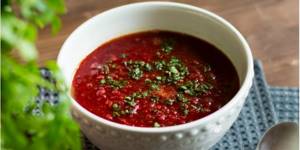
Diet stew
- Time: 30 minutes.
- Number of servings: 4 persons.
- Calorie content of the dish: 90 kcal/100 g.
- Purpose: for a snack.
- Cuisine: Caucasian.
- Difficulty: easy.
A simple and quick summer recipe for dietary vegetable stew, which is good served both hot and chilled. If desired, you can add a little salt to the dish and add a teaspoon of sour cream (this will increase the calorie content of a serving of stew by 15 kcal).
Ingredients
- eggplant – 2 pcs.;
- bell pepper – 3 pcs.;
- onion – 1 pc.;
- carrots – 1 pc.;
- tomato – 1 pc.;
- garlic – 4 cloves;
- greens – 7 g;
- olive oil – 1 tbsp.
Cooking method
- Cut the eggplants into slices, add salt and put under a press for 15 minutes.
- Grate the carrots, chop the onion, remove the seeds from the pepper, cut into half rings.
- Place vegetables in a cauldron, add oil, 100 ml of water, simmer covered over medium heat for 15 minutes.
- Peel the tomatoes and cut into cubes. Chop the garlic and herbs, add to the stew, simmer for another 7-10 minutes.
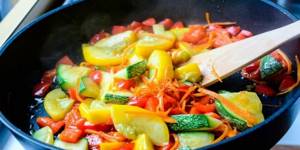
Casserole
- Time: 80 minutes.
- Number of servings: 4 persons.
- Calorie content of the dish: 120 kcal.
- Purpose: for breakfast.
- Cuisine: Russian.
- Difficulty: easy.
According to reviews from those losing weight, zucchini casserole with cottage cheese is an excellent option for a tasty and satisfying breakfast. These two dietary products go well together; you can serve the dish hot or cold, having prepared it the night before.
Ingredients
- milk zucchini – 300 g;
- low-fat cottage cheese – 250 g;
- egg – 2 pcs.;
- flour – 200 mg;
- salt - a pinch.
Cooking method
- Grate the zucchini on a coarse grater, let stand for 10–15 minutes, squeeze out the juice.
- Grind the cottage cheese with a fork and the egg.
- Mix zucchini with cottage cheese, add flour, add salt, knead thoroughly.
- Place the resulting mixture on a baking sheet and bake in the oven at 180° for 35–45 minutes.
Bird
| Goose carcass |
| Turkey carcass |
| Chicken liver |
| Chicken heart |
| Chicken stomach |
| Duck carcass |
| Chicken thigh |
| Chicken drumstick |
| Chicken breast |
| Chicken carcass |
| Egg, white |
| Egg, yolk |
| Chicken egg (1 piece) |
Harm
It is unlikely for a healthy person to cause harm to health when consuming vegetables and fruits. The main thing is to control the quality and quantity of food consumed.
Individual restrictions exist in the presence of serious illnesses. People with certain stomach diseases are unable to eat tomatoes and sour fruits. Many people are allergic to citrus fruits and strawberries. People with this problem know for sure which products should be treated with caution.
All vegetables have some characteristics. For example, eating a large amount of potatoes puts a strain on the pancreas, and beets have a laxative effect.
The presence of vegetables and fruits in the daily diet is beneficial for human health. The low calorie content of dishes made from them allows you not to feel hungry during diets.
You may also be interested
4 out of 5
Wanting to get rid of excess weight, we, one way or another, approach the issue of a balanced diet. How to supply the body with the necessary substances and satisfy the feeling of hunger without harming your figure? The best way out in this situation would be to enrich your diet with vegetables, the calorie content of which is so low that many do not even waste time counting it.
In addition, British scientists were able to establish that the more vegetables a person eats, the more satisfied he is with life. Do you want to be slim and happy? Then regularly use a variety of vegetables in your menu, and the result will not take long to arrive. Very soon you will feel that your health has improved, and your body has begun to lose excess weight.
Vegetables
| Eggplant |
| White cabbage |
| Ripe potatoes |
| Corn |
| Green onion |
| Bulb |
| Bulgarian pepper |
| Radish red |
| Celery root |
| Green beans |
The most useful vegetables for weight loss
Eating vegetables helps normalize many metabolic processes and starts the process of losing weight. During the boiled diet, it is recommended to consume:
- Beetroot (49 kcal/100 g) – normalizes intestinal motility and copes well with the problem of constipation.
- Carrots (25 kcal/100 g) – easily digested, normalizes intestinal motility.
- Zucchini (23 kcal/100 g) – the boiled vegetable increases the amount of folic acid, niacin, and vitamin A (substances involved in fat metabolism).
- Asparagus (22 kcal/100 g) – when boiled, it contains more beta-carotene, lutein, and vitamin A.
- Cruciferous vegetables: white cabbage, cauliflower, Brussels sprouts, broccoli, turnip (22/47/41/27/32 kcal/100 g) – normalize the functioning of the thyroid gland.
Fruits
| Orange |
| Grape |
| Grapefruit |
| Mandarin |
Now you know more about the energy value of foods. Choose the right foods for your diet and be healthy!
Our respect to the dear regulars of our site! We have collected very important information and are in a hurry to entrust it to you.
Its value is primarily for those who seek to reduce their weight, but it is also useful for those who want to maintain a healthy, balanced diet.
Energy value of foods table - what is it for, how to calculate the amount of calories needed and its chemical composition?
Also get answers to how many calories you need for a certain area of activity.
Since school, we know that our body needs to breathe, drink, eat and rest. These are, perhaps, the main points that we cannot live without.
If everything is more or less clear with air, drink and rest, then the daily intake of calories remains an unsolvable mystery for many. Have you also encountered this problem? Let's find the answers together!
Energy value of fruits
Some of them are real fat burners. Firstly, it is grapefruit - it cleanses the body well of waste and toxins. 100 grams of product contain only 35 calories. By eating two medium-sized fruits, you will not only not gain weight, but, on the contrary, you will be able to get rid of several kilograms. Secondly, a higher calorie apple (46 kcal) will also make you much slimmer. The fruit is ideal for fasting days, replacing your favorite unhealthy sweets. Thirdly, I would really like to note that pineapple (48 kcal) is beneficial for your figure, which perfectly breaks down fats and satisfies the feeling of hunger.
The calorie content of vegetables and fruits differs significantly: the table above shows that the first of them have a fairly low energy value. Fruits are higher in calories. The championship goes to the exotic fruits dates, apricots, dried apricots and avocados - 281, 278, 272 and 223 kcal, respectively. Among domestic varieties, grapes, cherries and apricots are the leaders, but their nutritional value is significantly lower than that of their overseas “brothers” - 69.49 and 46 kcal. The most harmless berries for your figure are cloudberries, viburnum and sea buckthorn. Their energy value does not exceed 30 calories.
Formula for success
Regardless of what reasons or advice, you still decided to lead a healthy lifestyle and
And the first thought that came to you was what and how much I should eat. As for nutrition, we recommend that you look at other topics on our website in the section.
Now we will calculate how much food to eat per day in order to maintain the body’s energy and at the same time not accumulate fat. Back in the 90s, a formula for the norm of calories consumed was derived and to this day it is the most accurate.
Of course, age should be taken into account (at different periods of life we spend the body’s energy differently); weight (the more you weigh, the more energy it takes to move); how active you are in life and, of course, your gender.
So, prepare a piece of paper and a pen, we will derive an individual formula.
First, we determine how much energy your body spends at rest (metabolism, breathing, nail/hair growth and the functioning of all internal organs).
SP – state of rest.
Women's SP = 9.99 * kg (weight) + 6.25 * cm (height) - 4.92 * age - 161
SP for men = 9.99 * kg (weight) + 6.25 * cm (height) - 4.92 * age + 5
After receiving the SP result, depending on your active lifestyle, we will determine how much energy your body spends daily:
- Inactive/sedentary lifestyle: SP*1.2
- Light loads (training up to three times a week): SP*1.375
- Moderately active (classes up to five times a week): SP* 1.55
- Active lifestyle (workout up to seven times a week): SP* 1.725
- Very active (daily training): SP*1.9
For example, let’s calculate for a woman 30 years old and a lifestyle with little stress.
SP=9.99*49+6.25*162 – 4.92*30 – 161=489.51+1012.5 –147.6 –161=1193.41
SP*1.375= 1193.41*1.375=1641
This means that this lady will multiply 1641 calories by 0.8 to lose weight and get 1312 calories per day. And the weight will definitely come off.
Consuming less than 1200 calories per day is very dangerous for your body and is not recommended without the supervision of a doctor!
However, sometimes there are cases when kilograms need to be gained rather than lost. How much do you need to increase your caloric intake to gain weight? Depending on the desired result, the consumption rate should be increased by 15–20%.
A lady with a weight of 49 kg and a height of 162 dreams of gaining 5 kg. Then the norm of 1641 calories should be multiplied by 15%.
1641*1.15=1887 calories per day.
The Best Foods for Mass Gain
To build muscle mass, you should increase your daily caloric intake. This, however, does not mean that you need to eat all high-calorie foods in a row.
For a healthy diet, focus on complete proteins and complex carbohydrates.
| Product category | Recommendations |
| Meat products | Along with boiled breasts, make scrambled eggs, as well as steaks and chops from lean meat. |
| Dairy | Any dairy products are allowed, but it is better to focus on whey protein and cottage cheese as a source of casein. |
| Fish and seafood | Boiled, fried and steamed fish and seafood. |
| Vegetables | Limit your consumption of fresh vegetables, as fiber will prevent the food you eat from being absorbed. |
| Fruits | Limit sugary fruits for fast carbohydrates or use them post-workout. |
| Beverages | Avoid alcohol - it suppresses protein synthesis in the body and reduces the ability of muscles to recover after exercise. |
| Nuts and seeds | Limit your serving size as nuts are difficult for the body to digest and will cause discomfort in the digestive tract if consumed in large quantities. |
| Cereals and legumes | Oatmeal, buckwheat and lentils have a moderate glycemic index and provide the body with many beneficial microelements. |
| Pastries and sweets | Limit these foods due to fast carbohydrates. Can be used as a cheat meal or immediately after training. |
| Sauces | Give preference to vegetable oil - artificially prepared sauces contain a lot of preservatives and salt. |
Start a discussion Cancel reply
What are calories?
In the large calorie table you will find the calorie content of the product you need.Calorie content is indicated per 100 g.
To search , use the keyboard shortcut CTRL + F and enter the search word.
One calorie is the amount of energy released when a gram of water evaporates at 1 degree Celsius. Calories are like gasoline. Only if gasoline makes a car move, then calories move our body.
Enzymes in our digestive system break down chemical bonds in food molecules. Thereby releasing the energy contained in the connections and giving it to the body.
This energy is needed for the functioning of the whole organism. When you don't use calories (maybe by skipping a workout or eating at night), they accumulate and are stored in the liver.
Glycogen (glucose) is quickly converted into energy in your body. So, thanks to energy reserves, you can constantly move, and the natural processes in the body do not slow down. Remember: there is a direct connection between your muscles and your liver in terms of calorie metabolism (approximately 300-400 kilocalories depending on your metabolic rate). But when you start consuming more calories than you can store, they begin to be stored as fat.
The body needs recharge every 3-4 hours. The liver retains exactly as much glycogen as it needs. Some of it goes into the muscles for short-term storage. This energy will be useful to you during sports.
Laboratory heat generation methods are used. Scientists calculate the weight of each trace element, and then calculate the final number, following the formula: in fats - 9 kcal per 1 g, in proteins and carbohydrates - 4 kcal per 1 g.
There is no exact formula. After all, this is influenced not only by constant indicators, such as weight and height (the more you weigh, the more calories you need to burn), age, but also by variable values, for example, activity (everyone has their own level of athletic endurance).
Thus, a 25-year-old woman weighing 60 kg, leading an active lifestyle (fitness club - 6 days a week), consuming approximately 2570 kilocalories per day, finds it easier to maintain her normal weight than a 40-year-old woman weighing 55 kg ( visits the fitness club only three times a week), consuming only 1930 kilocalories.

Vegetables
| calories, kcal | digestion, hour | |
| Eggplant | 24 | 3.3 |
| Swede | 34 | 3.1 |
| Zucchini | 23 | 2.3 |
| White cabbage | 27 | 3 |
| Sauerkraut | 19 | 4.1 |
| Brussels sprouts | 43 | 4 |
| Kohlrabi cabbage | 42 | 3 |
| Red cabbage | 24 | 3.4 |
| Cauliflower | 30 | 2.2 |
| Potato | 80 | 2 |
| Young potatoes | 61 | 2 |
| Sweet potatoes (yam) | 61 | 3 |
| Green onion | 19 | 3 |
| Leek | 33 | 2.3 |
| Bulb onions | 41 | 3.1 |
| Carrot | 34 | 3 |
| cucumbers | 14 | 2.4 |
| Pickles | 13 | 4 |
| Parsnip (root) | 47 | 3.3 |
| Patissons | 19 | 3.1 |
| Sweet green pepper | 26 | 3 |
| Sweet red pepper | 27 | 3 |
| Parsley | 49 | 3 |
| Parsley (root) | 53 | 3.3 |
| Rhubarb (stalks) | 16 | 3 |
| Radish | 21 | 3.1 |
| Radish | 35 | 3.4 |
| Turnip | 27 | 4 |
| Salad | 17 | 2.3 |
| Beet | 42 | 3 |
| Celery | 3.1 | |
| Celery (root) | 32 | 3.3 |
| Asparagus | 21 | 3 |
| Tomatoes | 23 | 2 |
| Dill | 31 | 3.1 |
| Horseradish | 44 | 3.4 |
| Cheremsha | 36 | 3.1 |
| Garlic | 46 | 2.4 |
| Spinach | 22 | 3 |
| Sorrel | 19 | 2.4 |

| Fruit Berries | calories, kcal |
| Apricot | 44 |
| Avocado | 100 |
| Quince | 30 |
| Cherry plum | 38 |
| A pineapple | 40 |
| Orange | 41 |
| Watermelon | 38 |
| Banana | 60 |
| Cowberry | 41 |
| Grape | 73 |
| Cherry | 53 |
| Pear | 42 |
| Melon | 39 |
| Blackberry | 32 |
| Strawberries | 38 |
| Kiwi | 50 |
| Dogwood | 41 |
| Cranberry | 33 |
| Strawberry | 36 |
| Gooseberry | 48 |
| Lemon | 21 |
| Raspberries | 45 |
| Mango | 70 |
| Mandarin | 41 |
| Peach | 44 |
| Plum | 44 |
| White currant | 40 |
| Red currants | 43 |
| Black currant | 45 |
| Persimmon | 62 |
| Cherries | 53 |
| Blueberry | 44 |
| Apple | 44 |

| Dried fruits | calories, kcal | digestion, hour |
| Dried apricots | 227 | 2.4 |
| Dried apricots | 234 | 2.4 |
| Raisin | 262 | 2 |
| Pear | 201 | 3 |
| Dried apricots | 227 | 2.4 |
| Prunes | 242 | 3 |
| Dates | 271 | 2 |
| Dry rosehip | 221 | 3.4 |
| Apples | 199 | 2.4 |

| Cereals | calories, kcal | digestion, hour |
| Soft winter wheat | 290 | 3.4 |
| Durum wheat | 301 | 3.4 |
| Rye | 287 | 3.3 |
| Buckwheat | 295 | 3.3 |
| Sweet corn | 245 | 2.4 |
| Corn | 325 | 3 |
| Oats | 250 | 3.2 |
| Millet | 311 | 3.2 |
| Rice | 283 | 3 |
| Barley | 264 | 3.4 |

| Cereals | calories, kcal | digestion, hour |
| Buckwheat | 335 | 3 |
| Buckwheat (done) | 329 | 2.3 |
| Corn | 337 | 2.3 |
| Oatmeal | 303 | 3 |
| Hercules | 305 | 2 |
| Oatmeal | 306 | 2 |
| Millet | 348 | 3 |
| Rice | 330 | 3 |
| Pearl barley | 320 | 3 |
| Barley | 324 | 2.3 |
| Manna | 328 | 2 |
| Wheat "Poltavskaya" | 316 | 2 |

| Dairy products, cheeses | kcal |
| Cow's milk cheese | 260 |
| Yogurt nat. 1.5% fat | 51 |
| Low-fat kefir | 30 |
| Full fat kefir | 59 |
| Milk | 58 |
| Whole milk powder | 475 |
| Condensed milk | 135 |
| Condensed milk with sugar | 315 |
| Curdled milk | 58 |
| Ryazhenka | 85 |
| Cream 10% | 118 |
| Cream 20% | 205 |
| Sour cream 10% | 116 |
| Sour cream 20% | 206 |
| Special cheeses and curd mass | 340 |
| Russian cheese | 371 |
| Dutch cheese | 361 |
| Swiss cheese | 396 |
| Poshekhonsky cheese | 334 |
| Processed cheese | 226 |
| Fat cottage cheese | 226 |
| Cottage cheese semi-fat | 156 |
| Low-fat cottage cheese | 86 |

| Fats, oils | kcal |
| Rendered fat | 897 |
| Pork bacon (without skin) | 816 |
| Milk margarine | 746 |
| Sandwich margarine | 744 |
| Mayonnaise | 627 |
| Vegetable oil | 899 |
| Butter | 748 |
| Ghee | 887 |

| Legumes | kcal |
| Beans | 58 |
| Peas | 323 |
| Whole peas | 303 |
| Soybeans | 395 |
| Beans | 309 |
| Lentils | 310 |

| Mushrooms | kcal |
| White fresh | 25 |
| White dried | 209 |
| Fresh boletus | 31 |
| Fresh boletuses | 31 |
| Fresh russula | 17 |

| Flour | calories, kcal | digestion, hour |
| Wheat flour, premium | 334 | 3.3 |
| Wheat flour, 1st grade | 331 | 3.2 |
| Wheat flour, 2nd grade | 324 | 3.2 |
| Wheat flour | 298 | 3.2 |
| Seeded rye flour | 304 | 3.2 |
| Peeled rye flour | 298 | 3.2 |
| Rye wallpaper flour | 293 | 3.2 |
| Soy flour | 374 | 3.2 |
| Low-fat soy flour | 292 | 3.2 |
| Corn flour | 330 | 3.2 |
| Barley flour | 284 | 3.2 |
| Pasta, premium | 337 | 3.2 |
| Milk pasta | 345 | 3.2 |
| Egg pasta | 345 | 3.2 |
| Rye bread | 181 | 3.3 |
| Rye-wheat bread | 189 | 3.3 |
| Borodino bread | 207 | 3.3 |
| Pecked bread | 227 | 3.3 |
| Wheat grain bread | 231 | 3.1 |
| Wheat bread, 1st grade | 231 | 3.1 |
| Palyanitsa bread | 247 | 3.1 |
| Cheburek | 243 | 3.1 |
| Pita | 277 | 3.1 |
| Sliced loaf 1st grade | 235 | 2.5 |
| City bun | 266 | 2.5 |
| Kalach Moscow | 249 | 2.5 |
| Rye flatbread | 367 | 2.5 |
| Butter bun | 337 | 2.5 |
| Vyborg baked goods with poppy seeds | 304 | 2.5 |
| Moscow bun | 336 | 2.5 |
| Sprinkled horns | 314 | 2.5 |
| Premium flour biscuits | 415 | 2.3 |
| Premium flour crackers | 439 | 2.3 |
| Premium sugar cookies | 436 | 2.4 |
| Butter cookies | 458 | 2.4 |
| Almond cookies | 486 | 2.4 |
| Custard gingerbread | 350 | 2.4 |
| Simple bagels | 317 | 2.3 |
| Butter bagels | 349 | 2.3 |
| Simple bagels | 284 | 2.3 |
| Bagels with poppy seeds | 316 | 2.3 |
| Sweet straw | 373 | 2.3 |
| Simple dryers | 341 | 2.3 |
| Mustard drying | 379 | 2.3 |
| Vanilla dryers | 377 | 2.3 |
| Army crackers | 308 | 2.3 |
| Road rusks | 341 | 2.3 |
| Premium cream crackers | 398 | 2.3 |

| Confectionery | calories, kcal | digestion, hour |
| Bars made with confectionery fat | 523 | 2 |
| Nut dragee | 552 | 2.3 |
| Fruit dragee in chocolate | 389 | 2.3 |
| Iris semi-solid | 395 | 2 |
| Candy caramel | 370 | 2 |
| Fruit caramel | 357 | 2 |
| Caramel with liqueur | 358 | 2.1 |
| Chocolate-nut caramel | 420 | 2.3 |
| Milk candies | 364 | 2 |
| Fondant candies | 369 | 2 |
| Roasted sweets | 523 | 2 |
| Cream candies | 523 | 2 |
| Fruit candies | 369 | 2 |
| Chocolate candies | 569 | 2 |
| Marshmallow | 304 | 2 |
| Fruit and berry marmalade | 293 | 2 |
| Paste | 310 | 2.2 |
| Sunflower halva | 523 | 3.3 |
| Tahini halva | 516 | 3.3 |
| Chocolate without additives | 544 | 2 |
| Milk chocolate | 550 | 2 |
| Chocolate with nuts | 580 | 2.3 |
| Waffles with fruit filling | 350 | 2.3 |
| Waffles with fatty filling | 539 | 3 |
| Crumb cake | 438 | 3 |
| Almond cake | 431 | 3 |
| Fruit cake | 435 | 3.3 |
| Puff pastry with cream | 555 | 4 |
| Tube cake with cream | 329 | 4 |
| Cake with fruit filling | 391 | 3.3 |
| Layer cake with cream | 533 | 4 |
| Meat products | calories, kcal | digestion, hour |
| Rabbit meat | 183 | 3.1 |
| Pig meat | 109 | 3.1 |
| Veal 1 category | 97 | 3.1 |
| Lamb 1st category | 209 | 3.3 |
| Lamb breast | 288 | 3.3 |
| Lamb loin | 255 | 3.3 |
| Lamb thigh | 198 | 3.3 |
| Buffalo meat 1st category | 195 | 3.3 |
| Camel meat 1st category | 160 | 3.3 |
| Beef 1 category | 218 | 3.3 |
| Beef tenderloin | 106 | 3.3 |
| Beef brisket | 233 | 3.3 |
| Beef thigh | 104 | 3.3 |
| Beef udder | 175 | 3.3 |
| Beef liver | 105 | 3.1 |
| Beef kidneys | 86 | 3.1 |
| Beef heart | 96 | 3.1 |
| Beef tongue | 173 | 3.3 |
| Venison 1st category | 155 | 3.3 |
| Pork meat | 357 | 4 |
| Pork is fatty | 491 | 4.3 |
| Pork tenderloin | 142 | 3.3 |
| Pork belly | 602 | 4.3 |
| Pork loin | 384 | 4.3 |
| Pork thigh | 305 | 4 |
| Pork feet | 234 | 4 |
| Pork liver | 109 | 3.1 |
| Pork tongue | 208 | 3.3 |
| Pork bacon (without skin) | 841 | 4.3 |
| Salted pork fat | 816 | 4.3 |
| Yak meat | 112 | 3.3 |
| Boiled diabetic sausage | 254 | 3 |
| Boiled doctor's sausage | 257 | 3 |
| Boiled veal sausage | 310 | 3 |
| Boiled tea sausage | 216 | 3 |
| Smoked amateur sausage | 309 | 3.5 |
| Smoked Krakow sausage | 466 | 4 |
| Smoked Ukrainian sausage | 376 | 4 |
| Smoked hunting sausages | 463 | 4 |
| Raw smoked grainy sausage | 608 | 4.2 |
| Raw smoked sausage servelat | 461 | 4.2 |
| Special ham | 126 | 3.4 |
| Ham meat bread | 256 | 3.5 |
| Pork ham in shape | 279 | 4 |
| Smoked-baked pork belly | 514 | 4.3 |
| Raw smoked pork belly | 605 | 4.3 |
| Raw smoked pork loin | 475 | 4.3 |
| Boiled pork ham | 288 | 4 |
| Beef sausages | 215 | 3 |
| Pork sausages | 332 | 3.3 |
| Amateur sausages | 226 | 3 |
| Milk sausages | 266 | 3 |
| Beef in its own juice | 247 | 3.3 |
| Beef stew | 220 | 3.3 |
| Tourist breakfast (beef) | 196 | 3.3 |
| Separate sausage mince | 279 | 3.1 |
| Pork stew | 349 | 3.3 |
| Minced pork sausage | 244 | 3.1 |
| Meat pate | 277 | 3 |
| Liver pate | 317 | 3 |
| Meat dumplings | 255 | 3.3 |

| Bird | calories, kcal | digestion, hour |
| Geese 1st category | 412 | 3.4 |
| Turkeys 1st category | 276 | 3.3 |
| Chickens category 1 | 241 | 3.2 |
| Quails of the 1st category | 230 | 3.2 |
| Ducks category 1 | 405 | 3.3 |
| Chicken leg | 185 | 3.2 |
| Chicken fillet | 113 | 3.2 |
| Chicken stomach | 130 | 3.2 |
| Chicken liver | 140 | 3.2 |
| Chicken heart | 159 | 3.2 |
| Chicken in its own juice | 184 | 3.2 |
| Minced chicken sausage | 193 | 3 |

| Fish and seafood | calories, kcal | digestion, hour |
| Fresh roach | 95 | 3.1 |
| Cold smoked roach | 181 | 4.3 |
| Dried Caspian vobla | 235 | 4.3 |
| Pink salmon | 147 | 3.1 |
| Salted pink salmon | 169 | 4 |
| Carp | 112 | 3.1 |
| Baltic sprat | 137 | 4 |
| Salted Baltic sprat | 137 | 4.3 |
| Hot smoked sprat | 162 | 3.1 |
| Bream | 105 | 3.1 |
| Sea bream | 143 | 3.1 |
| Salted Caspian bream | 144 | 4 |
| Dried Caspian bream | 221 | 4.3 |
| Hot smoked bream | 172 | 4.3 |
| Cold smoked bream | 160 | 4.3 |
| Pollock | 104 | 3.1 |
| Spring capelin | 116 | 3.1 |
| Autumn capelin | 217 | 3.1 |
| River perch | 103 | 3.1 |
| Fresh sea bass | 220 | 3.1 |
| Sea mount perch. smoking | 175 | 4.3 |
| Cold smoked perch (balichok) | 199 | 4.3 |
| Sturgeon | 82 | 3.1 |
| Dried sturgeon balyk | 177 | 4.3 |
| Cold smoked sturgeon balyk | 194 | 4.3 |
| Haddock | 71 | 3.1 |
| Large saury | 262 | 3.1 |
| Small saury | 143 | 3.1 |
| Fresh fatty herring | 246 | 3.1 |
| Lean fresh herring | 135 | 4.1 |
| Atlantic salted herring | 145 | 4 |
| Atlantic mackerel | 191 | 3.1 |
| Salted-dried smelt | 264 | 4.1 |
| Oceanic horse mackerel | 114 | 3.1 |
| Horse mackerel cold. smoking | 94 | 4.3 |
| Zander | 84 | 3.1 |
| Cod | 69 | 3.1 |
| Salted cod | 98 | 4 |
| Hot smoked cod | 115 | 4.3 |
| Tuna | 136 | 3.1 |
| Acne | 333 | 3.1 |
| Pike | 84 | 3.1 |
| Squid (meat) | 110 | 2.3 |
| Kamchatka crab (meat) | 96 | 2.3 |
| Shrimp (meat) | 95 | 2.3 |
| Rapana clam | 77 | 2.1 |
| Mussels | 50 | 2.1 |
| Pinniped meat | 113 | 3.1 |
| Sea kale | 5 | 2 |
| Granular pink salmon caviar | 230 | 2.3 |
| Chum salmon caviar granular (red) | 251 | 2.3 |
| Pollock caviar, punched | 131 | 2.3 |
| Sturgeon caviar granular | 203 | 2.3 |
| Pressed sturgeon caviar | 236 | 2.3 |
| Spicy salted sprat | 141 | 3.3 |
| Canned seaweed | 8 | 2.3 |
| Canned natural “shrimp” | 81 | 3 |
| Canned natural “crabs” | 85 | 3 |
| Canned cod liver | 613 | 3 |
| Natural canned food "Gorbusha" | 136 | 3 |
| Natural canned food “Mackerel” | 258 | 3 |
| Canned horse mackerel in oil | 309 | 3.3 |
| Canned cod in oil | 289 | 3.3 |
| Canned food in oil "Sprats" | 363 | 3.3 |
| Canned pink salmon in tomato | 132 | 3 |
| Canned horse mackerel in tomato | 110 | 3 |
| Canned pike perch in tomato | 119 | 3 |
| Pasta "Ocean" | 92 | 3 |

| Smoked meats, canned food | kcal |
| Beef stew | 232 |
| Tourist breakfast (beef) | 176 |
| Tourist breakfast (pork) | 206 |
| Sausage mince | 213 |
| Pork stew | 349 |
| Raw smoked brisket | 632 |
| Raw smoked loin | 467 |
| Ham | 279 |

| Eggs | kcal |
| Chicken egg | 157 |
| Egg powder | 542 |
| Protein powder | 336 |
| Dry yolk | 623 |
| Quail egg | 168 |

| Caviar | kcal |
| Chum salmon granular | 251 |
| Bream punch | 142 |
| Pollock punch | 131 |
| Sturgeon granular | 203 |
| Sturgeon punch | 123 |

| Nuts | kcal |
| Hazelnut | 704 |
| Almond | 645 |
| Walnut | 648 |
| Peanut | 548 |
| Sunflower seeds | 578 |
| Pistachios | 620 |
| Pine nuts | 620 |
| Cashew | 600 |
| Sesame seeds | 610 |
| Chestnut | 170 |
| Brazilian nut | 687 |

| Soft drinks | Kcal / 250ml |
| Orange juice | 123 |
| Grapefruit juice | 75 |
| Cola | 110 |
| Coffee without milk and sugar | 0 |
| Tea with sugar | 90 |
| Lemonade | 123 |
| Mineral water | 0 |
| carrot juice | 68 |
| Apple juice | 118 |

| Alcoholic drinks, alcohol | Kcal |
| White wine, 125 ml | 99 |
| Whiskey, 20 ml | 48 |
| Vodka, 20 ml | 55 |
| Gin, 40 ml | 130 |
| Calvados, 20 ml | 65 |
| Campari, 50 ml | 56 |
| Cognac, 20 ml | 49 |
| Red wine, 125 ml | 93 |
| Liqueur, 20 ml | 65 |
| Madera, 50 ml | 60 |
| Beer, 250 ml | 112 |
| Rum, 20 ml | 75 |
| Sake, 20 ml | 50 |
| Champagne brut, 100 ml | 85 |
Types of carbohydrates
Carbohydrates are divided into simple (fast) and complex (slow).

Simple carbohydrates, in turn, are divided into 2 large groups:
- Monosaccharides enter the body through the consumption of fruits, confectionery and sugar.
- Glucose is formed from disaccharides and starch. It quickly enters the blood. Honey has the most glucose - about 34%, grapes - 7.5%, berries - 5%. Its deficiency or excess negatively affects the body.
- Fructose is not quickly absorbed in the intestines. Foods high in fructose lead to excess weight, since fructose can be broken down into fats faster. Fructose is often used to replace sugar, which reduces calories in food.
- Disaccharides.
- Lactose is formed from glucose and galactose under the action of lactase. It is found in dairy products. The most lactose is found in milk - about 4.6%, sour cream and yogurt - 3%.
- Sucrose is quickly broken down in the gastrointestinal tract. Its main components are glucose and fructose. Beetroot contains the most sucrose - about 8.5%.
Complex carbohydrates include:
- The body receives polysaccharides from cereals, legumes, and vegetables.
- Pectin acts as an adsorbent. It absorbs harmful substances and removes them from the body. Pectin can be found in root vegetables, gooseberries, currants and some fruits.
- Starch is found in 80% of carbohydrate foods. The leaders in starch content are rice - 68-70% and buckwheat - 59%. Potatoes contain only 18%. Starch has high energy value. When you eat foods with starch, hunger will not appear soon.
- Glycogen is found in animal products (red meat, fish and organ meats). In the liver its amount is about 10%. Glycogen is capable of repairing muscles. When the amount of glucose in the body decreases, glycogen can replace it for a while.
- Fiber is a fiber of plant origin. It makes it possible to monitor the amount of sugar in the blood and normalizes the functioning of the gastrointestinal tract. When consuming fiber, a person remains full for a long time. Fiber is found in vegetables and fruits, nuts and grains.
Calorie content of oils, table
| Product | Water | Squirrels | Fats | Carbohydrates | Kcal |
| Rendered fat | 0,2 | 0 | 99,8 | 0 | 899 |
| Pork bacon | 5,5 | 1,3 | 92,9 | 0 | 819 |
| Milk margarine | 15,6 | 0,2 | 82,4 | 0,9 | 745 |
| Creamy margarine | 15,7 | 0,5 | 86 | 2,2 | 815 |
| Mayonnaise | 24 | 3,2 | 65 | 2,5 | 634 |
| Vegetable oil | 0,1 | 0 | 99,9 | 0 | 901 |
| Butter | 15,7 | 0,6 | 82,6 | 0,8 | 752 |
| Ghee | 1 | 0,2 | 99 | 0,5 | 888 |
Calorie content of oils, fats, table

Oil, fats and mayonnaise are the highest calorie foods. They have a high calorie content and are well digestible.
Important: You need to consume such foods in minimal quantities if you want to lose weight and never return to the past.
Balanced diet
A properly selected diet containing proteins, fats and carbohydrates can improve a person’s condition and fight excess weight. You cannot refuse any component, since the body needs all the substances.
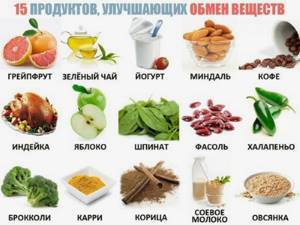
It could be:
- The daily meal plan should contain about 50% carbohydrates, of which more should be consumed at breakfast.
- To improve metabolism and reduce stress on the body, you need to eat 4-5 times a day (3 main meals and 1-2 snacks).
- Complex carbohydrates are best consumed before physical activity, so that you have enough strength and energy left for training.
- Carbohydrate foods are best consumed separately from proteins and fats. This is due to the fact that carbohydrates are broken down faster. The body receives the energy it needs and makes less effort to break down fats, which are then deposited on the body.
- Don’t forget about physical activity, which burns not only extra pounds, but also energy.
- Complex carbohydrates should be included in your diet; they help fill you up. But you need to use them according to the norm.
- For breakfast, you need to eat food that contains proteins, fats and carbohydrates. Such food will launch metabolic processes for the whole day
- For dinner, you should generally avoid eating carbohydrate-containing foods. Since the energy received is no longer needed, it goes into fat deposits. It is better to eat only protein foods. The exception is people who work shifts or at night.
- To prevent carbohydrates from turning into fat deposits, you should not drink during or immediately after meals. It is best to do this in advance or after 40-60 minutes.
- For those who want to lose excess weight, you need to give up simple carbohydrates for some period.
And in no case should you completely give up carbohydrates, as they are important in the structure of the body. You can also lose weight with carbohydrates. You need to study the glycemic index of foods and select foods from those that are allowed and those with a lower value.
If you follow the table on the presence of carbohydrates in food and consume them wisely, all this will only benefit the body and provide a person with strength and energy.
Author: Julia Winters
Article design: Anna Vinnitskaya
Table of negative calorie foods
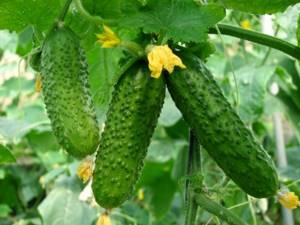
Nowadays, you can hear about negative calorie foods for weight loss on TV or among people. What are these foods and what does negative calorie mean?
These are food products for the processing of which our body spends more energy resources than it receives. This all happens because our digestive tract has to work hard to digest the dietary fiber and fiber from these foods.
Table of foods with negative calorie content:
| Products | Kcal |
| Spinach | 21 |
| bell pepper | 26 |
| Apples | 44 |
| Lemon | 30 |
| Salad | 15 |
| Rhubarb | 16 |
| Radish | 20 |
| Sea kale | 5 |
| Tomatoes | 15 |
| Grapefruit | 33 |
| Eggplant | 25 |
| Carrot | 31 |
| cucumbers | 10 |
Important: Create a menu for weight loss and include these products in it. They will help you lose excess weight without any effort.
Vegetable side dish “European”
In European countries, especially in Great Britain, the side dish that we will prepare is very popular. All components for it are available at any time of the year. It’s delicious, and it gives us so many “benefits”! Be sure to try cooking it!
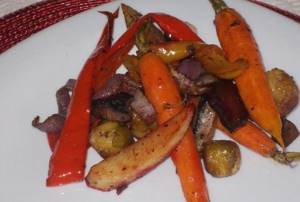
Ingredients:
- carrots - six fruits (small size);
- potatoes - two root vegetables;
- Brussels sprouts – 150 g;
- red onion - head;
- bell pepper – three pieces;
- garlic cloves – three pieces;
- beets - one root vegetable;
- mushrooms - five pieces;
- salt (preferably sea salt) – one teaspoon. spoon;
- olive oil – 25 ml;
- pepper blend;
- honey - one table. spoon;
- balsamic vinegar - three tablespoons. spoons.
Preparation:
- We will prepare the products we need. It is better to take peppers of different colors, then the dish will play with bright colors.
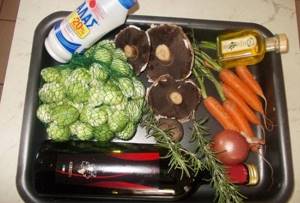
- Clean the peppers, rinse and dry.
- Chop medium-sized peppers into strips.
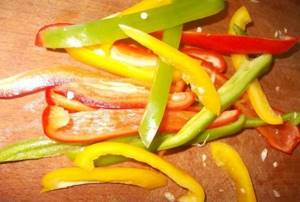
- Peel and wash the carrots. We do not cut off the tails completely (as in the photo).

- Remove the top leaves from the cabbage (this way it won’t taste bitter). Let's cut the heads of cabbage down to the ground.
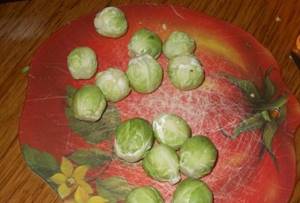
- Clean and wash the beets. Let's cut it into circles.
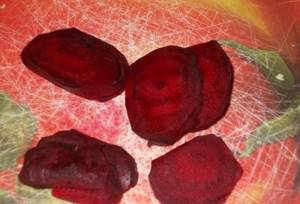
- Clean, rinse and dry the mushrooms.

- Cut the mushrooms into not too small slices.
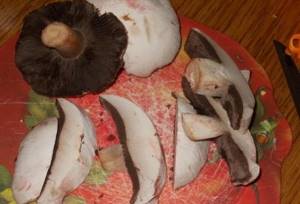
- Let's clean the onion. Let's chop it into half rings. Let's separate them from each other.
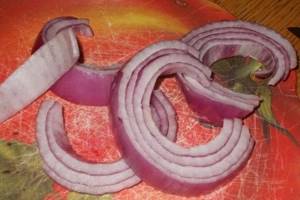
- Peel the garlic cloves and cut them into slices.
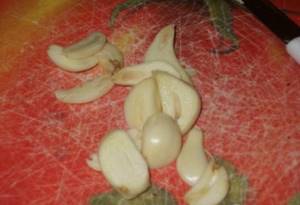
- Let's peel the potatoes. Cut it into bars along the root crop. By the way, you can complement the taste of the side dish with parsnips and pumpkin pulp.
- Let's prepare salt and a blend of peppers. Sea salt is needed, since under its influence vegetables will not change their color.

- Place assorted vegetables and mushrooms on a baking sheet.
- Salt and sprinkle with pepper.
- Pour the workpiece with olive oil. Let's stir well.
- Place a couple or three sprigs of rosemary on top of the assorted vegetables.
- Bake the side dish at one hundred and seventy degrees for thirty minutes.

- In the meantime, let's make the sauce. For it we need honey and balsamic vinegar.

- Combine vinegar and honey in a deep bowl and stir until smooth.
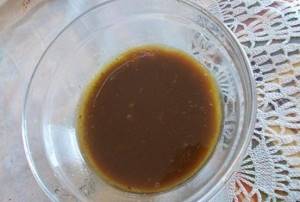
- After thirty minutes, pour the prepared sauce over our side dish. Stir well and bring the mixed vegetables to readiness.
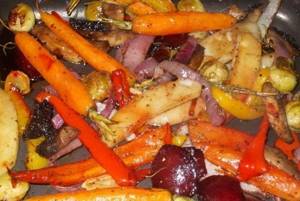
- Serve our side dish while it is hot.
Calorie content of vegetable salads for weight loss
Of course, most vegetables are tasty on their own, but you always want to diversify the menu with unusual dishes that are healthy for your figure. The easiest way to prepare vegetables is to make a salad that combines the beneficial properties of its ingredients.
The calorie content of a vegetable salad for weight loss is calculated by summing the number of calories of each product included. As an example, let me offer you a recipe for a delicious and healthy salad.
Vegetable salad “Breath of Summer”
- Tomato – 100 g (16 kcal);
- Cucumber – 100 g (15 kcal);
- Parsley – 10 g (4.7 kcal);
- Bell pepper – 50 g (13.5 kcal);
- Olive oil – 5 g (44.9 kcal);
- Salt – 2 g (0 kcal).
The total weight of the salad is 267 g, the total number of calories is 94.1 kcal, that is, the calorie content of such a salad per 100 g will be 35.3 kcal. Thus, the low calorie content of vegetable salad allows you to use such a dish for the benefit of the body and without harm to the figure.

